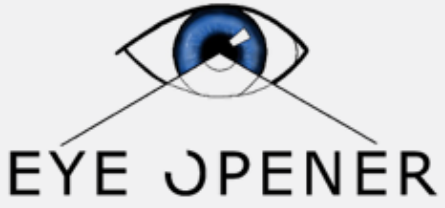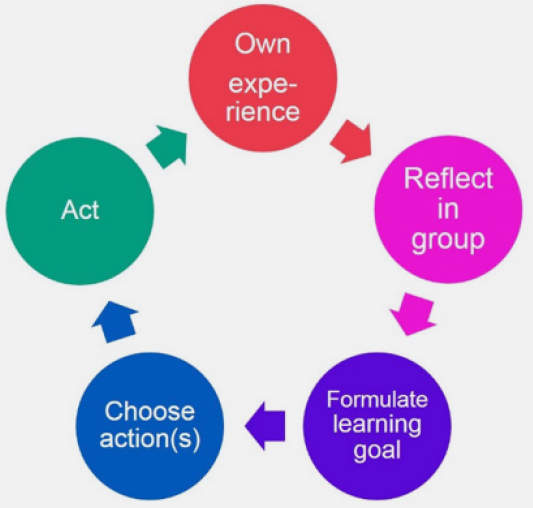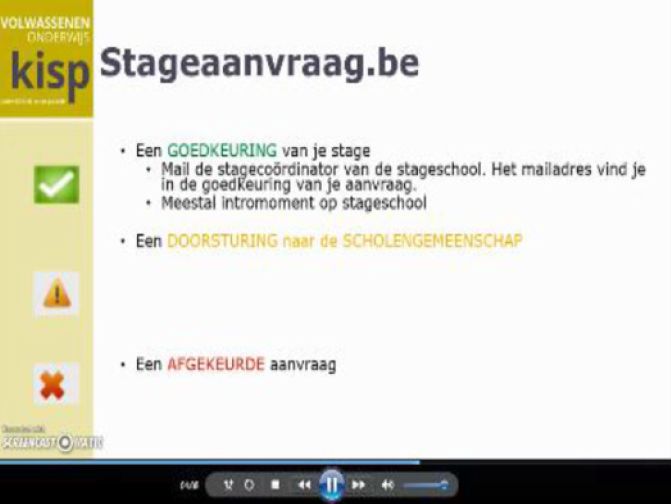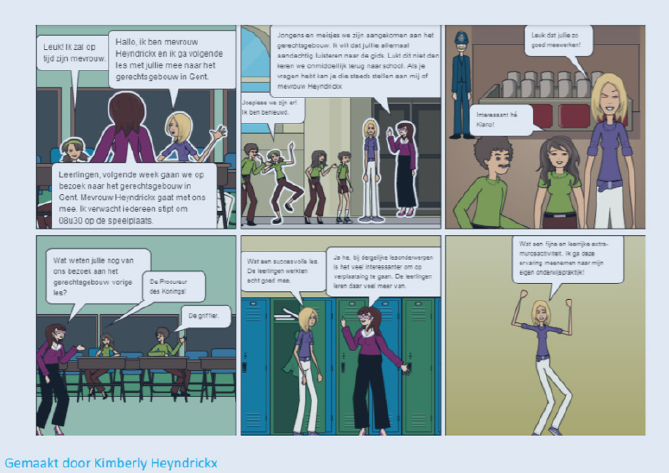Eye Opener - How can teacher trainers coach students during internships taking the diversity of students into account?
Introduction
The Expertise Network of teacher training of the Ghent University Association (ENW AUGent) funded the Eye Opener project. The main goal of the project was to support teacher trainers in adequately addressing the diversity of students during their internships. During the academic year 2014-2015, six teacher trainers of three different teacher training institutes in Ghent (University College Ghent (HoGent), Ghent University (UGent) and Adult Education Center Kisp (CVO Kisp)) participated in an inter-vision group guided by two process managers.
One of the inspiring frameworks that was used to improve the quality of student coaching was Universal Design for Learning (UDL; Rose & Meyer, 2002). Other frameworks that were used were Solution Focused Coaching (SFC; de Shazer, 1985) and Core Qualities (Ofman, 2007).
This article will focus on the concept, the process and the product of the Eye Opener project. In addition, three good practices will be discussed in-depth.
The concept
The Eye Opener project used inter-vision as learning method. By using this structured method (Terpstra, 2010), the teacher trainers reflected within the group on how they could coach their students during internship, taking the diversity of students into account. The inter-vision group consisted six teacher trainers, and was organised five times in one academic year. Two process managers stimulated the process of inspiring, motivating and activating each other. The strength of the Eye Opener project was the co-creation of new ideas and actions, and to develop a broader vision on diversity of students. In the following sections, the three guiding frameworks will be discussed.

Universal Design for Learning (UDL)
The first framework used in the Eye Opener project was UDL (Rose & Meyer, 2002). During the first session, an expert explained the UDL vision and principles, and provided different examples of UDL implementation in (higher) education. The teacher trainers were asked to discuss in groups the extent to which they had already realised some UDL principles in the coaching of students. Furthermore, the teacher trainers mentioned challenges for further implementation of UDL in their coaching of students in internships.
For the Eye Opener project, the UDL principles (CAST, 2016) were transformed into questions which activated the teacher trainers:
- The why of learning: How do you stimulate interest and motivation for learning?
- The what of learning: How do you present information in different ways?
- The how of learning: How do you differentiate the ways that students can express their skills?
Solution Focused Coaching (SFC)
In contrast with a problem-focused approach, solution-focused thinking focuses on the future. Critical to SFC is to identify the goal to move toward, to discover strengths and capacities, and to identify and take small steps toward the solution. During the sessions, the process managers used solution-focused questions to coach the teacher trainers. They asked about solutions, strengths and actions (Caufman & van Dijk, 2011; Visser & Schlundt Bodien, 2009).
Core Qualities
Each teacher trainer had their own strengths, own preferences and own experiences. By using the framework of Core Qualities (Ofman, 2007) during the sessions, the teacher trainers became more aware of their own qualities, pitfalls, sensitivities and challenges. These aspects of the identity of the teacher trainer have a substantial impact on their professional relationship with the students.
Process
Inspired by the cycle of action research (Ponte, 2006), the teacher trainers were encouraged to investigate and to improve the way they coach their students during internships. The starting point of the sessions was to share and reflect on each teacher trainer’s own experience in coaching students. In the next step, the teacher trainer formulated at least one personal learning goal. Then followed a brainstorm in the inter-vision group of possible actions according to the personal goal. At the end of the session, the teacher trainer chose a corresponding action fitting their own professional identity which was carried out in their own coaching of students. This resulted in new experiences which created a new starting point (Van de Putte, et al., 2010).
- Own experience
- Reflect in group
- Formulate learning goal
- Chooose actions
- Act

Three examples of good practice
Each of the teacher trainers in the group of Eye Opener carried out different actions during their own coaching of students in internships. Following the process inspired by action research, this resulted in a number of good practices. In this article, three good practices are illustrated and linked with the UDL principles.
Good practice 1: How to activate students?
The first good practice focuses on the coaching session, which takes place after a lesson taught by the student. This session involves a conversation and reflection between the student and the teacher trainer. The goal of the first good practice is to reinforce the input of the student during this coaching session.
The coaching procedure created in the Eye Opener project involves different steps. In step one, both the student and teacher trainer write down three positive experiences about the lesson on three yellow post-its. In step two, both the student and the teacher trainer write down three ideas to improve the lesson on blue post-its. In step three, the student starts a conversation with the teacher trainer about the lesson, using the positive experiences he has written down on the yellow post-its. These experiences are compared to the ones written down by the teacher trainer. At the end, the student receives all the post-its generated during the coaching session.
Link to UDL principles
This first good practice can be linked to all the UDL-principles. The why of learning is met because the input of the student is clearly recognised. The student does not only listen to the findings of the teacher trainer, but also contributes actively in the conversation about his performance. The what of learning is met by giving oral and visual feedback. The visual feedback is reinforced by using keywords on the post-its and using different coloured post-its. The how of learning is that the post-its help the student to reflect on his/her own performance and to formulate priorities.

Good practice 2: How to make information accessible
The second good practice focuses on the application procedure for an internship. In Flanders (Dutch speaking part of Belgium), this is a rather complex procedure for all teacher training institutes supported by the government. In the past, there was a text brochure available for students and a group session was organised to inform the students. For a lot of students, particularly those who could not attend the information session, it was very difficult to complete the application procedure in a correct way. In order to provide more accessible information about the application procedure for internships, an instruction movie was developed. Screencastomatic© was used with a voice-over that explained the procedure step by step. In addition, different visual cues were added (for example colours, symbols, screenshots).
Link to UDL principles
This second good practice is an example of the what principle of UDL because the information is presented in different ways: there is an explanation in voice-over, as well as visual markers like structures, colours and symbols.

Good practice 3: How to encourage students to express their skills
In the third good practice, the teacher trainer encourages the students to express their competencies in a personal and creative way. For example, some students may use artwork while others make a video or comic to describe the policy of a school. For both the student and the teacher trainer, this ‘freedom’ of expressing skills feels more pleasant: the student can show his/her talents and the teacher trainer gets a broader view of the student.
Link to UDL principles
This third good practice is an example of the how principle of UDL, because the students are given the opportunity to express their skills in their own personal way. In addition, this also enhances the motivation for learning, as mentioned in the why principle.

Conclusion
The main goal of the Eye Opener project was to professionalise teacher trainers in adequately addressing the diversity of students during their internships, by means of an inter-vision group. The participants concluded that it was an inspiring and motivating project. Reflecting and learning together created a new and broader vision on diversity of students. They came to the realisation that small actions can have a big impact. They enjoyed the strength of sharing and co-creating which gave them new energy to explore more possibilities to take the diversity of students into account.
Contact
For more information about the Eye Opener project contact: Katrien Durinck: Katrien.Durinck@hogent.be An Standaert: An.Standaert@hogent.be
References
CAST, retrieved from http://www.cast.org/ourwork/about-udl on September 22, 2016.
Cauffman, L., & van Dijk, D. J. (2011). Handboek oplossingsgericht werken in het onderwijs. Boom: Uitgeverij Lemma.
Ofman, D. (2007). Hé, ik daar...?! Ontdek en ontwikkel je persoonlijke kernkwaliteiten met het kernkwadrant. Utrecht/Antwerpen : Kosmos Uitgevers.
De Shazer, S. (1985). Keys to solution in brief therapy. W.W. Northman& Company, Inc.
Eye Opener: http://eyeopenerenwaugent.weebly.com/ (2015) for illustrations made by Taco Bals (logo) and the participants in the Eye Opener project.
Ponte, P. (2006). Onderwijs van eigen makelij. Procesboek actieonderzoek in scholen en opleidingen. Soest: Uitgeverij Nelissen.
Rose, D. H., & Meyer, A. (2002). Teaching every student in the digital age: Universal Design for Learning. Association for Supervision and Curriculum Development.
Terpstra, O. T. (2010). Intervisie en selectie. Tijdschrift voor Medisch Onderwijs, 321-322.
Van de Putte, I., Roos, D., Vandevelde, S., De Windt, E., De Wilde, J., & Van den Abbeele, G. (2010). Klassewerk: het GOL(L)D-concept. Gent: Academia Press.
Visser, C. & Schlundt Bodien, G. (2009). Paden naar oplossingen. De kracht van oplossingsgericht werken. Driebergen- Rijsenburg: uitgeverij Just in Time
